A Baltimore company shares lessons learned in growing its business with help from Small Business Innovation Research funding.
David Chaffee, Contributor
Perseverance is the
most important factor in garnering a Small Business Innovation Research (SBIR) award,
according to Brimrose Corp.’s founder and CEO. And he should know.
In 1984, Dr. Ron Rosemeier found himself at the end of his postdoc
with the University of Maryland and nothing to show for it. His SBIR applications
had been rejected 20 times. He had maxed out his credit cards, piling up $100,000
in debt. He had been unemployed for three months. The dream of this self-described
technology geek to start his own photonics company appeared to be over before it
had begun.
But then his willingness to stick it out began paying dividends:
He and the little company he had started, Baltimore-based Brimrose Corp., scored
four SBIRs in six months. Three of those went on to become Phase II SBIRs, a conversion
percentage much higher than the norm. From less than zero, he now had $2 million
in the bank. And he never looked back.
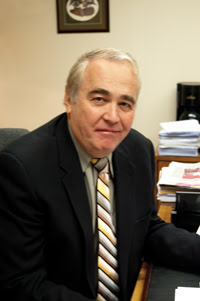
Brimrose Corp. founder and CEO Ron Rosemeier would be the first to
say that SBIRs have been critical to the company’s success. Images courtesy
of Brimrose Corp.
The power of the SBIR had taken Brimrose from early near-bankruptcy
to, 27 years later, employing 60 full-time employees and supplying staple products
for the largest pharmaceutical companies in the world, including AstraZeneca and
Bristol-Myers Squibb. A small company, it now finds itself competing with huge conglomerates
Foss and Bruker.
In all, Brimrose has been granted 65 Phase I and 28 Phase II SBIR
awards totaling more than $60 million. Yet Rosemeier is confident enough to say
that if the SBIR program went away tomorrow, Brimrose would be fine. In fact, as
any healthy company over time should do, Brimrose has weaned itself to the point
where 80 percent of its revenues now come from commercial and other non-SBIR funding
sources.
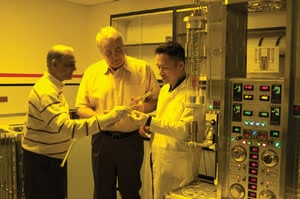
Rosemeier and Sudhir Trivedi, director of research, evaluate just-manufactured
crystals with the help of another staff member.
Broad range of applications
Brimrose’s near-IR acousto-optic tunable filters came out
of SBIRs, but the company recognized that the technology’s ability to precisely
and instantaneously characterize the ingredients in a substance would have enormous
consequences in various fields, from pharmaceuticals to agriculture and more. “This
is a good replacement for standard spectroscopy, where they have mechanical grating,”
Rosemeier said. “The acousto-optic tunable filter was the perfect device to
be able to introduce all of these mechanical technologies in optical spectroscopy.”
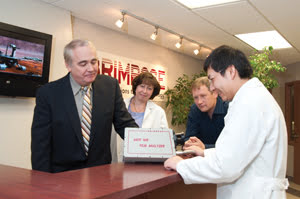
One of Brimrose’s most successful deliverables is its infrared acousto-optic tunable
filter.
And now pharmaceutical companies can measure elements to the parts-per-trillion
level. Agriculturalists can measure the amount of oil in a seed of corn. Tobacco
companies can measure nicotine, tar or whatever they want almost instantaneously.
The Munich Airport uses the devices to analyze jet fuel. Acousto-optic tunable filters
have been selected for use on Mars by NASA to measure the potential for water content
in soil and rocks. They are used in university labs and geological labs. They are
used by robots in toxic environments.
Another winning characteristic of successful SBIR bidders is the
ability to learn from mistakes. Dr. Sudhir Trivedi, who directs R&D, says the
company learns from the constructive criticism provided after every unsuccessful
effort. “After every rejection, you fine-tune your proposal – you learn
from your mistakes,” he said.
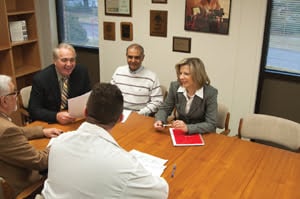
The Brimrose executive team, including CEO Ron Rosemeier, chief technology officer Jolanta Soos,
and director of research Sudhir Trivedi, evaluate an SBIR with other staff.
Most recently, the company has linked up with Rutgers University
to win an STTR to study the potential applications of coupling acousto-optics with
diffraction gratings. It is an effort to combine the powers of acousto-optics and
electro-optics.
The critical relationship between SBIRs and Brimrose has not escaped
the attention of federal policy makers. The US Congress has sought Rosemeier’s
advice as it tries to make SBIR relevant to the 21st century. Becoming the voice
of the SBIR awardee, Rosemeier seeks to have more businesspeople on the federal
teams and wants to see the same standards used for each of the 11 agencies that
implement them. He also advocates for longer Phase I and Phase II time periods to
make for better responses.
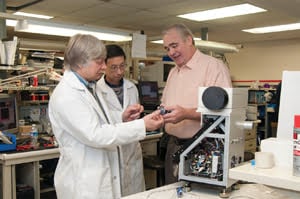
Rosemeier and the concept-to-utilization team evaluate a new product idea. The team was designed
to take concepts used for SBIRs and translate them into workable commercial products.
SBIRs were not made so that companies would become SBIR mills,
existing solely on that one source of funding. In fact, companies that choose that
route generally end up dying out quickly or being sold when they cannot make the
predictable stream of payroll with the at times unpredictable SBIR awards. One company
had terrific optical cryptography technology but could not transfer it to commercial
product and was purchased by a larger company that only does federal contracts.
Companies that find ways to take the technologies developed from
SBIRs and make them into commercial products are the companies that become and remain
viable.
Meet the author
C. David Chaffee is a writer based in Ellicott City, Md., and
is the former Washington editor of Photonics Spectra; e-mail: [email protected].
Lessons learned
Along the way, Rosemeier and his
colleagues at Brimrose have learned some tricks for getting SBIRs as well as the
accompanying Small Business Technology Transfer (STTR) awards – and for converting
Phase I SBIRs to Phase IIs.
1. There is, of course, the perseverance that Rosemeier puts first.
“I wanted this to be an old-fashioned company, not supported by venture capital,”
he said. He also was adamant that his company be a technology company. This thinking
led inevitably to the pursuit of SBIRs, allowing him to receive funds and develop
technology at the same time.
2. Rosemeier has designed his company around innovation – the
“I” in “SBIR.” The company has various units: production,
software, mechanical and so on, all ready to take a concept and turn it into something
tangible.
3. He learned this model during his PhD days at Johns Hopkins University,
where he saw the workings of professor Robert Green’s materials science division.
“He had a machine shop; he had mechanical guys; he had electrical guys. I
basically built Brimrose on the same model,” Rosemeier said.
4. Collaboration also is a critical element of the company’s
success, particularly as it takes ideas and converts them into tangible products.
Brimrose’s concept-to-utilization team, which has representatives from all
elements of the company, including manufacturing, software and mechanical engineering,
meets weekly to guide projects.
5. Many SBIRs have nothing to show but paper at the end of Phase
I, but Rosemeier believes it is vital that “at the end of Phase I we have
deliverables – we actually build hardware.” This philosophy has had
dividends with large federal contractors. “They see it, and they want a few,”
he said. “When they want more than a few, we know we are on to something.”
Rosemeier recognizes that a number of these federally funded products have to lead
to products that can survive on their own in the commercial world. The company also
has had success introducing its products to customers at trade shows such as CLEO
and SPIE Photonics West.
For more information on the US government’s Small Business Innovation Research
program and Small Business Technology Transfer program, visit http://www.sbir.gov/federal_links.htm.